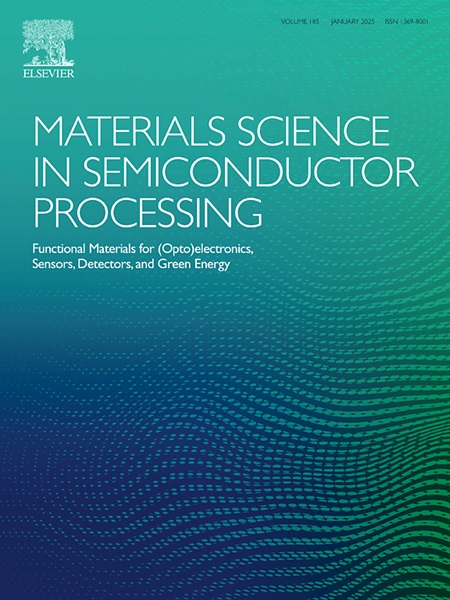在二元准二维InI相中,非谐波和粒子类声子传播主导着超低晶格热导率
IF 4.6
3区 工程技术
Q2 ENGINEERING, ELECTRICAL & ELECTRONIC
引用次数: 0
摘要
了解SnSe等准二维范德华(vdW)材料的超低导热性和声子输运,对于推进热电功能材料领域的研究至关重要。我们的研究采用综合的方法,在第一原理框架内结合声子玻尔兹曼方程和维格纳输运方程,深入研究了准二维InI的非调和性和各向异性声子动力学。InI与SnSe具有正交晶体结构,具有独特的堆叠准二维层状排列,由于层间耦合弱和声子行为明显的各向异性,导致平均导热系数非常低(在300和800 K之间为0.73-0.32 W/mK)。为了揭示这种各向异性低热导率的物理基础,我们分析了各向异性粒子状κp和波状κc的贡献。我们的研究表明,颗粒状的κp主导着热导行为。虽然热导率值与实验数据相当吻合(在300和800 K之间约0.5 W/mK),但与其他钙钛矿或锌钛相材料不同的非线性依赖行为,不能仅仅归因于分支间波状隧道的重要性日益增加。通过研究和理解双声子通道,如分支间波状隧道和粒子对超低导热vdW材料(如InI)热传输的贡献,我们可以更深入地了解潜在的声子动力学,并为特定应用优化热性能。这一发现为发现具有低κL和定制热输运特性的vdW化合物开辟了新的途径。本文章由计算机程序翻译,如有差异,请以英文原文为准。
Anharmonic and particlelike phonon propagation dominates ultralow lattice thermal conductivity in the binary quasi-2D InI phase
Understanding the ultra-low thermal conductivity and phonon transport in quasi-2D van der Waals (vdW) materials like SnSe is essential for advancing the field of thermoelectric functional materials. Our study delves into the anharmonicity and anisotropic phonon dynamics of quasi-2D InI using a comprehensive approach that combines the phonon Boltzmann equation and Wigner transport equation within a first principles framework. InI, sharing an orthorhombic crystal structure with SnSe, showcases a distinctive stacked quasi-2D layered arrangement, resulting in remarkably low averaged thermal conductivity (0.73–0.32 W/mK between 300 and 800 K) due to weak interlayer coupling and pronounced anisotropy in phonon behavior. To unravel the physical underpinnings of this anisotropic low thermal conductivity, we analyze the anisotropic particle-like κp and wave-like κc contributions. Our investigation reveals that the particle-like κp predominantly governs the thermal conductivity behavior. While the thermal conductivity values align reasonably well with experimental data (∼ 0.5 W/mK between 300 and 800 K), the non-linear dependency behavior, distinct from other perovskite or Zintl phase materials, cannot be solely attributed to the increasing significance of interbranch wavelike tunneling. By investigating and comprehending the dual-phonon channels, such as interbranch wavelike tunneling and particle contributions to thermal transport in ultralow thermal conductivity vdW materials like InI, we can gain deeper insights into the underlying phonon dynamics and optimize thermal properties for specific applications. This exploration opens up new avenues for discovering vdW compounds with low κL and tailored thermal transport characteristics.
求助全文
通过发布文献求助,成功后即可免费获取论文全文。
去求助
来源期刊

Materials Science in Semiconductor Processing
工程技术-材料科学:综合
CiteScore
8.00
自引率
4.90%
发文量
780
审稿时长
42 days
期刊介绍:
Materials Science in Semiconductor Processing provides a unique forum for the discussion of novel processing, applications and theoretical studies of functional materials and devices for (opto)electronics, sensors, detectors, biotechnology and green energy.
Each issue will aim to provide a snapshot of current insights, new achievements, breakthroughs and future trends in such diverse fields as microelectronics, energy conversion and storage, communications, biotechnology, (photo)catalysis, nano- and thin-film technology, hybrid and composite materials, chemical processing, vapor-phase deposition, device fabrication, and modelling, which are the backbone of advanced semiconductor processing and applications.
Coverage will include: advanced lithography for submicron devices; etching and related topics; ion implantation; damage evolution and related issues; plasma and thermal CVD; rapid thermal processing; advanced metallization and interconnect schemes; thin dielectric layers, oxidation; sol-gel processing; chemical bath and (electro)chemical deposition; compound semiconductor processing; new non-oxide materials and their applications; (macro)molecular and hybrid materials; molecular dynamics, ab-initio methods, Monte Carlo, etc.; new materials and processes for discrete and integrated circuits; magnetic materials and spintronics; heterostructures and quantum devices; engineering of the electrical and optical properties of semiconductors; crystal growth mechanisms; reliability, defect density, intrinsic impurities and defects.
 求助内容:
求助内容: 应助结果提醒方式:
应助结果提醒方式:


